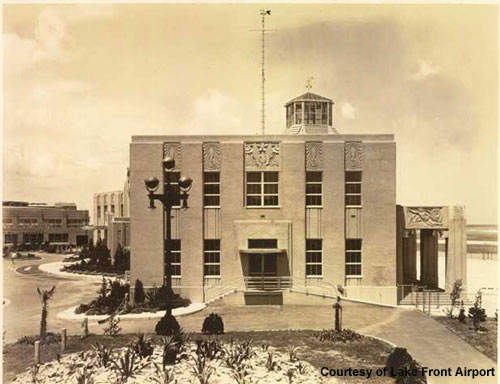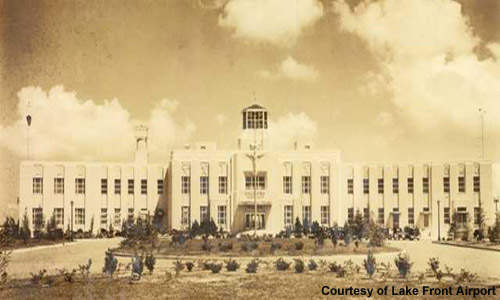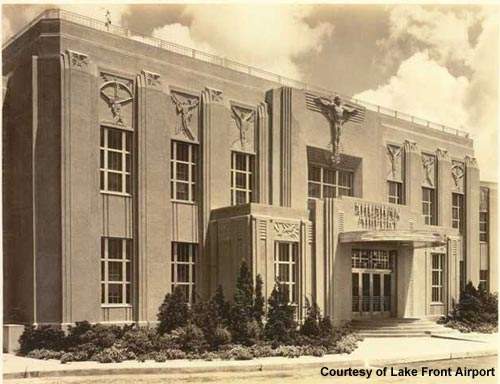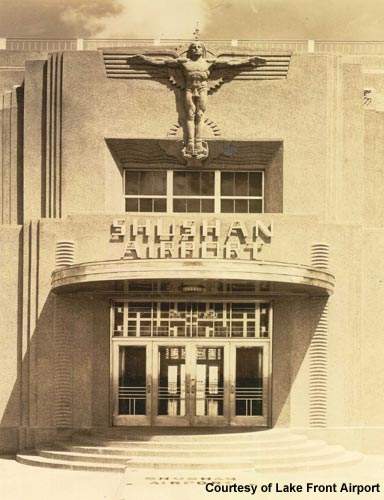The Lake Front Airport in New Orleans or as it used to be known ‘Shushan Airport’ (named after the former US Senator who was instrumental in getting it built) is a general aviation airport on Lake Pontchartrain (some of it was built on a peninsula of land reclaimed from the lake by the Orleans Levee Board).
The airport, which was first opened in February 1934 has one of the finest examples of an art deco terminal building in the US. There are three asphalt runways; 18R/36L (6,880ft, 2,097m) (24-hour VFR, VOR and GPS approach), 18L/36R (3,697ft, 1,127m) and 9/27 (3,113ft, 949m). Services offered include full service fuel, flight training, line service and aircraft rescue crews.
The airport is mostly used for general aviation, a Cessna flight training centre (Gulf Coast Aviation), Dayjet on-demand non-stop commercial service to 14 US cities and also some military operations. In 2005 the airport was damaged significantly by the Hurricane Katrina winds and storm surge. The airport was soon restored to function but many offices are still in temporary trailers and the terminal building is still closed.
The Lake Front terminal
The Shushan Airport terminal complex was designed by Weiss, Dreyfous & Seiferth and was one of many art deco buildings produced at that time costing $4.5m to build. The terminal building was adorned inside by decorative murals by the celebrated artist Xavier Gonzales.
The terminal had such facilities as living quarters for passengers and pilots, a medical clinic, an outdoor swimming pool, the ‘Flying Lounge’ bar, the walnut room (an old venue for dances), a parachute store, an aluminium and glass ATC tower with rotating beacon (will be turned into an observation tower), a retail store, an upmarket restaurant (still open) and a spacious 2.5-storey reception hall.
The inside was decorated using pink granite and red, grey and cream terrazzo marble as well as ceramic and mosaic tiles. The overall appearance was one of luxury with additional artwork on the inside in the shape of a bronze coloured frieze of the history of aviation and a sculpture for the middle of the lawn in front of the terminal by Enrique Alferez called ‘Fountain of the Four Winds’. The outside of the building is adorned by 9ft-high ornamental sculptured panels.
In the 1960s the airport received an ill fated restoration that saw many of its 150 windows bricked up or hidden behind large concrete panels. The building was turned into a featureless block resembling a fall-out shelter by a construction company called Cimini and Meric who erected the metal grid that holds the overlay concrete panels in place.
Airport restoration
A project is now underway to restore the art deco terminal to its former glory as it was in 1934. The restoration will see the removal of harmful materials from the terminal such as asbestos, and lead paint and then the repair of storm damaged walls, ceiling, duct work and cast iron pipes below the building.
The 1960s concrete panels will be carefully removed and the outside reliefs restored according to photographs of the terminal recovered from Tulane University. At the same time the inside mural artwork is undergoing restoration.
The work will require $10m and the funds will be made available from FEMA (Federal Emergency Management Agency) and insurance (the Foundation for Historical Louisiana may also set up a fund to support the project).
The architect for the terminal restoration project is Alton Ochsner Davis. An engineering and architectural consultancy called Richard C. Lambert Consultants LLC (RCLC) completed the engineering and construction design for the panel replacement project in mid-2008. The restoration project could take until 2010 to complete by the time the outside murals are restored by hand and specialist craftsmen are appointed to carry out other major projects. When the restoration is complete the terminal will be returned to duty as the main airport building but will also be a protected historic building.






